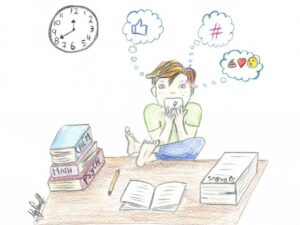Facilitating an Effective Classroom Discussion.

Facilitating an Effective Classroom Discussion.
Class discussion is a useful strategy for stimulating critical thinking and encouraging students to reexamine their attitudes.
For a discussion to be effective, students must possess some general information about the topic under consideration, unless you are using the discussion as an advance organizer to introduce a new topic.
The teacher’s role in a class discussion is as a moderator.
The teacher poses the initial question, facilitates thinking with follow-up questions, and ensures that everyone has an opportunity to participate.
He or she also introduces bits of information, but generally, it is best if the teacher refrains from offering an opinion.
If you do choose to take a position, it is probably wise to wait until the end.
It is important that you merely facilitate, not dominate, the discussion.
- Whole-class discussion is best facilitated with the group seated in a large circle or a horseshoe.
- If they can see each other, students are more likely to respond to each other rather than engage in a series of successive dialogues with the teacher.
- Do give some forethought to the stimulating questions you will ask to promote the discussion.
- It is best to write them down.
- Overall, the less you have to participate to keep the discussion going, the
- It is also essential to establish the procedures for taking turns
- Does the student need to be acknowledged by the teacher before speaking?
Begin the discussion by introducing the topic.
- Students need to be aware of the discussion’s general theme and have a sense of its purpose.
- A couple of sentences and an opening question may suffice.
- Discussions can serve a variety of purposes.
- They may focus on examining a problem and analyzing its causes, effects, and potential solutions.
- A discussion may be used to de-brief an activity such as a simulation, role play, or experiment.
- Discussion may focus on predicting some future event or explaining some past phenomenon.
- To meet any of these aims, the discussion must progress beyond the knowledge level.
- Higher-level cognitive questions must be asked.
The class may be broken into small groups to stimulate discussion.
- Each group might discuss the same topic or have separate topics to consider.
- It is helpful to provide the groups with a written list of questions, either as a handout or displayed on the overhead projector or
- Without a clear purpose and a task for which students will be accountable, the discussion will quickly degenerate into a
- It is usually a good idea to appoint a group leader who is responsible for keeping everyone on task, recording the group’s ideas, and reporting back to the whole class.
- To facilitate only one person talking at a time, bring a sponge ball or other soft object to
- To speak, a student must have the When a student wants to contribute to the discussion, he or she must raise a hand.
- The individual may speak only after he or she receives the ball from the previous student.
Avoid over-relying on high-ability students to keep the discussion going.
- A tactic that teachers commonly use to prevent several persons from dominating the discussion is to allocate each student three or four poker chips or other tokens.
- Each time a student comments, he or she must turn in one token to the
- Once their chips are gone, they may add no more comments to the discussion.
- Another way to control monopolization is to first break students into small groups and designate a reporter from each group to share the group’s
- Another option is to appoint the monopoliser to a role that inhibits his or her participation, for example, as a silent observer or recorder.
Provide some structure to the discussion so that it is not too divergent.
- It must have the focus to encourage serious reflection.
- An exchange of unexamined opinions is of minimal educational value.
- Don’t allow the discussion to deteriorate into a shouting
- Emphasize the value of having a free and open discussion and supporting positions with
- Emphasize that reasonable people may sometimes interpret those facts differently.
- End the discussion before it begins to
- Do something different: have each student take one minute to write an answer to a question, introducing some relevant
Provide closure to the discussion.
- One way is for the teacher or volunteers to summarize the main points
- Another is to have students reflect or write about how the discussion may have changed their views of the topic.
- Thank students for their contributions.
- It generally works best to reinforce but not grade participation in discussions.
- Provide a transition to the lesson’s next phase.
- Point out how the discussion fits into the overall lesson objectives.
Also read: Understanding Effective Mechanisms of Dealing with Shame.
Occasionally, it is helpful to lead a post-discussion review of the discussion’s process and techniques.
Encourage the class to analyze what went well and which areas might need improvement.
Encourage reflection on the level of thinking that occurred during the discussion.
Sometimes appointed observers can provide feedback on the group dynamics.
Join Enlighten Knowledge WhatsApp platform.
Join Enlighten Knowledge Telegram platform.






Hello!
Good cheer to all on this beautiful day!!!!!
Good luck 🙂
I wanted to post a simple note to say thanks to you for all of the fantastic tricks you are giving out at this site. My rather long internet look up has finally been honored with awesome facts and techniques to exchange with my colleagues. I would tell you that most of us site visitors are undoubtedly fortunate to exist in a wonderful network with many wonderful people with very helpful pointers. I feel pretty privileged to have seen your webpage and look forward to plenty of more fabulous moments reading here. Thank you again for a lot of things.